| |
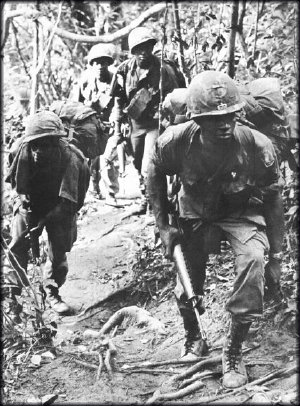 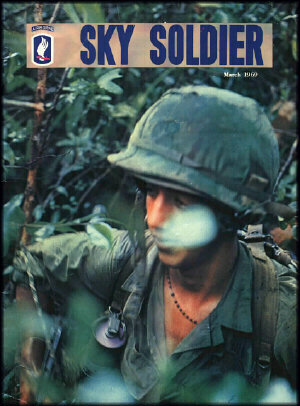 |
|
Front Cover and Inside Front
cover |

Contents
Volume 2, Number 3
March
1969
2. Taking Charlie's Tactics
Dogged
Paratroopers bewilder enemy
8. A Professional Breed
No two days
the same for Crew Chiefs
12. The Airborne Express
C S&S
Truckers never let up
14. A Precarious Way of
Living
Pointmen take pride in avoiding disaster
17. Tips from Madison Avenue
Chieu Hoi
is an Ad Man's Dream
20. Complicated Combat Mission
RTO's
can make or break a Company
26. How Ya Gonna Act ?
Chaplains see
refreshing new ethical standards
Other Items
11. Olive Drab and Useful
11. Sky Soldier of Month
22. Change of Command
23. 1/50th Routs Ambush
24. Supply Never Stops
28. The Four Deuce
1Lt Thomas E.
Gardo
Editor |
 |
Commanding
General
Brig Gen John W. Barnes
Deputy
Commander
Col Joseph R. Franklin
Executive
Officer
LTC John D. Bethea
Command Sergeant
Major
Sgt Major John Bittorie
SKY SOLDIER magazine is an authorized publication
of the 173d Airborne Brigade. It is published quarterly by the
Brigade Information Office for the Sky Soldier Association. Opinions
expressed are not necessarily those of the Department of the Army.
The 173d Airborne Brigade Sky Soldier Association
exists for the benefit of the trooper. The association is a
non-profit organization managed by selected members of the Brigade.
Cover Photos- Front cover by Sp4 Jon Hosier; 1/503d
Sky Soldier waits in the jungle near Bong Son. Rear cover by Sp4 Jon
Hosier; 1/503d troops rest in a rice paddy. Front inside by Sgt John
McCulloch; 2/503d searches for NVA. Back inside by Sp4 Adian
Acevedo; 2/503d makes another move from LZ English.
Pg 1 |
|
The squawk box crackled
continuously as Field Commanders relayed their situation reports to
the Brigade Tactical Operations Center. It was warm, but not
uncomfortably so, and in the soft fluorescent glow, Sergeants and
Junior Officers wasted no motion in collecting data, registering
reports and marking the green and brown operational maps which
blanketed the walls of the thickly sand-bagged nerve
center. |
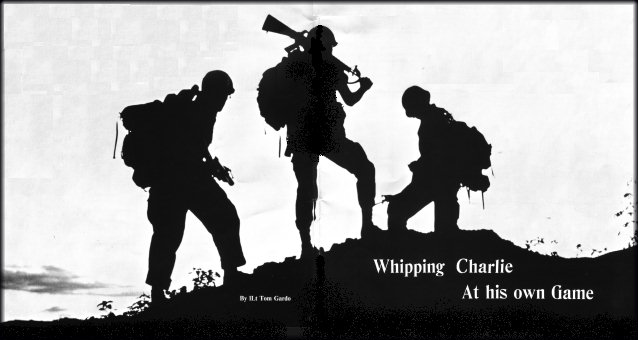 |
|
Inside a nearby room, away from
the garbled din, a stocky, squarejawed Major fingered the papers
strewn on his desk, and chewed viciously on a stubby brown
cigar.
Intelligence reports had been
increasing that the 18th NVA Regiment might be preparing harrassing
attacks against several pacification villages west of Highway One.
Major Arthur C. Stang III of Ridley Township Pa, jammed the cigar
into a makeshift ashtray and reached for the
phone.
Minutes later a team from the 74th
Infantry Long Range Patrol were being summoned for a reconnaissance
mission to take place the following morning, and Major Stang was
across the corridor in conference with Major Kenneth W. Accousti of
Stamford, Conn, the Brigade Operations Officer, discussing details
on how to get some Hawk teams from the 1st Battalion, 503d Infantry
into the area.
Within hours, the plan was set,
and by morning Brigadier General John W. Barnes had been briefed on
the small operation which would ultimately send the VC scattering
back into the jungle, bewildered about how the 173d Airborne Brigade
had again beaten them to the punch.
Operating
on the concept, "an ounce of prevention is worth a pound of cure,"
elements of the 173d Airborne Brigade during the months of December,
January and February broke down into increasingly small units,
sought out the enemy into his own Jungle sanctuaries and then
whipped him at his own game of ambush and
harrassment.
"In our area of operations,"
explained Brigadier General John W. Barnes, Brigade Commanding
General, "it's no longer a big unit war. The enemy has fragmented
his forces to avoid detection, and in turn, we have done likewise
and gone after him, saturating the areas that the enemy once could
call his own, meeting him on his own terms, ferreting him out and
destroying him."
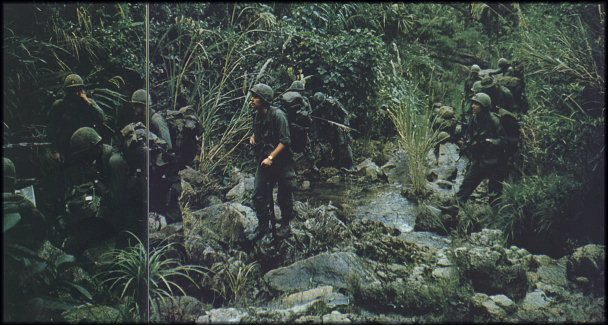
"Of course," he added, "this has
put a much greater responsibility on the small unit leader. It has
become a Squad and Platoon Leader's war, and they are doing a fine
job. We have conducted over 3,500 Hawk operations since November,
and they've accounted for nearly 80 per cent of our enemy
kills."
"We're nickel and diming the enemy to
death," added Major Accousti, who pointed out that these operations
have "shown more than anything else, the flexibility, adaptability
and imagination of the American Soldier."
"The
premium is now on soldierly abilities," asserted Colonel Joseph R.
Franklin, Deputy Brigade Commander. "It's six or eight of our men
out there in the jungle in a cat and mouse struggle, navigating in
the worst possible terrain, which the enemy knows and we don't,
against six or eight Viet Cong. It's not our technology that wins
out there, but who is the better man, and on nearly every occasion,
we're coming out on top. Believe me, this says a lot for American
youth."
During the first reporting period of
Hawk Operations, Brigade teams had killed 68 enemy while losing only
one man, and had directed the destruction of 257 bunkers and 56
standing buildings which had been previously hidden in the
jungle.
General Barnes explained further that
while the Viet Cong and NVA in the Brigade's AOs were indeed
becoming more difficult to "ferret out", at the same time, they were
becoming easier to destroy.
People Awaken
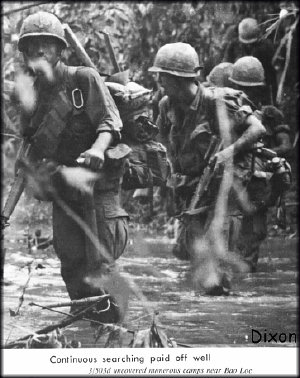
"It's really not difficult to
understand," said Major Stang. Because of the heavy losses that have
been inflicted upon the enemy by Allied Forces, he is being forced
to put troops in the field with less and less training. Morale is
very low on their side. They are experiencing great difficulty in
obtaining supplies of all types. The people are waking up to the
fact that the enemy's promises of victory just aren't coming true
and he can't get the sympathetic cooperation that he once could. His
recruiting has fallen way off. We're getting more and more Chieu
Hoi's who are just completely disillusioned."
Hawk Operations added considerably to the enemy's misery by moving
into remote areas where he once could feel safe and then ambushing
his trails and directing artillery and air strikes into his staging
areas and base camps, which before had been
undetected.
One of the most successful
operations of the period occurred in late December and early January
in the Mountains northwest of An Khe, when the 2nd and 4th
Battalions reacted to a potential threat to that region by flushing
out a host of base camps and storage areas which resulted in the
discovery of an enemy province headquarters and "fantastic"
documents which listed countless Viet Cong infrastructure personnel
by name.

Operation Sky Fire
During the operation, named Sky
Fire, Brigade elements killed 16 enemy, captured 21 weapons, 15,600
lbs of rice, 840 lbs of Medical supplies and destroyed 252 buildings
and 96 bunkers.
The Medical cache was
uncovered by Alpha Company, 4th Battalion, and included Medicinal
provisions which ranged from vitamin tablets to Opiums. Penicillin,
streptomycin, blood plasma, needles, syringes, constriction bands,
hot water bottles, surgical tape, malaria pills and soap were in
abundance, much of it ready for immediate use. Nearby, the Company
found what appeared to be a clothing supply point, containing 120
sets of black pajamas and 160 white surgical uniforms along with
1,800 feet of khaki material and 10 bundles of plastic
material.
Although there were no hospital
facilities, several days later A/2/503d found an enemy tunnel which
led to a cave complex harboring three operating tables, a mess hall,
sleeping area for 48 and a large wheat storage
bin.
Meanwhile, in the An Khe area, the 1st
Battalion (Mechanized) 50th Infantry was shouldering most of the
actual combat burdens. In the space of a week, the Mechanized
Infantrymen overwhelmed two potential ambush forces along Route 19.
Alpha Company, 1/50th, under the direction of Captain Walter D.
Kinard of Columbus, Ga, was credited with killing 28 enemy during
the first two weeks of January.
The Brigade
also received considerable air support from the Cavalrymen of Delta
Troop, 1st Air Cavalry. In one visual reconnaissance contact, the
Cav killed eight.
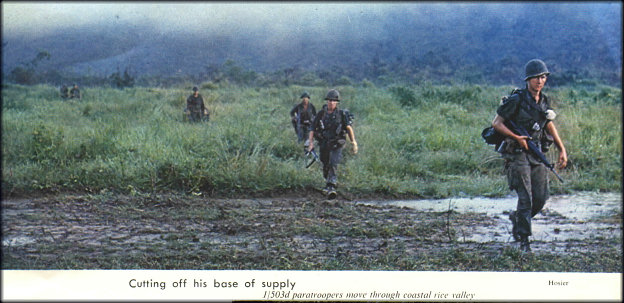
Cochise/Dan Sinh
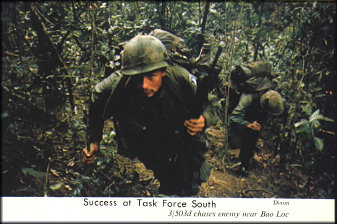
In Operation Cochise/Dan Sinh,
there was virtually no heavy contact during the three month period
as the Viet Cong went to great lengths to avoid the tenacious Hawk
search missions and devastating artillery barrages of the 3/319th
Artillery.
1st Battalion and 74th Infantry LRP
Hawk teams were particularly successful in the "nickel and dime"
tactics of picking off couriers and other VC who ventured toward
hamlets to conduct business.
Two significant caches were
turned up by Charlie Company, 2/503d Sky Soldiers, the first in
early December when they uncovered six tons of rice hidden in the
walls and under the floors of a village north of Bong Son, and the
second in late January when a Hawk team led by Sgt Stormy Arrow of
Hollywood, Fla, found a weapons cache that was
described as the "largest ever" during
Operation Cochise, Lieutenant General William R.
Peers, Commanding General, I Field Force sent a
special congratulatory telegram to the team.
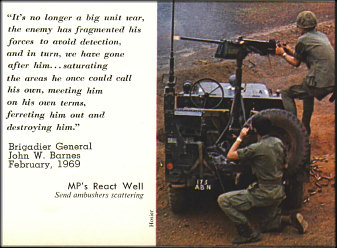 Meanwhile, to the south, in Operation Bolling,
while the 4th Battalion was away, Company D, 16th Armor had its
hands full securing the airfield, providing security for
construction on Highway 7 Bravo and serving as a reaction force for
the 47th ARVN Regiment. During two reactionary engagements, the
Airborne Armormen killed 31 Viet Cong in some daring night fighting.
Meanwhile, to the south, in Operation Bolling,
while the 4th Battalion was away, Company D, 16th Armor had its
hands full securing the airfield, providing security for
construction on Highway 7 Bravo and serving as a reaction force for
the 47th ARVN Regiment. During two reactionary engagements, the
Airborne Armormen killed 31 Viet Cong in some daring night fighting.
Success At Tuy Hoa
One of the battles saw D/16th
catch a VC Company in an open rice paddy as they retreated from the
ARVN's. The other saw D/16th's APC's storm through an abandoned
village where the VC were hiding in ambush and kill 20. February saw
the 4th Battalion return to the Tuy Hoa area and conduct a
successful "Crunch" Operation with 6 Battalions of Korean
troops.
The success of the Brigade and other
Allied operations near Tuy Hoa is readily shown in the fact that
when the Brigade came in 1967, 60 to 80 percent of the area rice
harvest was falling into VC hands. In the rice harvests of the past
year, Tuy Hoa exported rice.
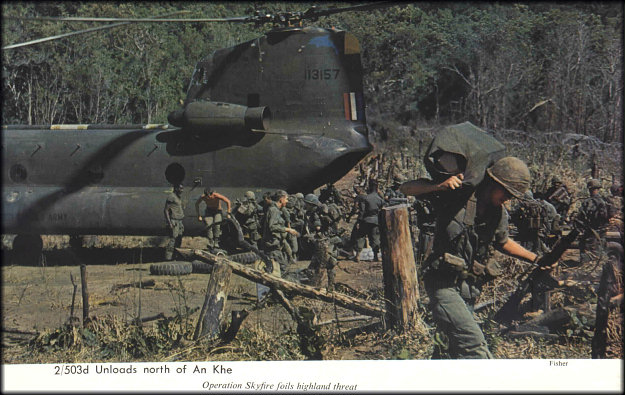
Achievements were also being
claimed by the 3rd Battalion, 503d Infantry, which continued to
operate in Task Force South, 200 miles to the south near Bao Loc.
Continuous reconnaissance in force operations in that area turned up
numerous base camps for the 3/503d, including a regimental
headquarters, 400 meters long and 200 meters wide, by Alpha Company.
In February the 3rd Battalion chased down a VC Regiment and killed
67.
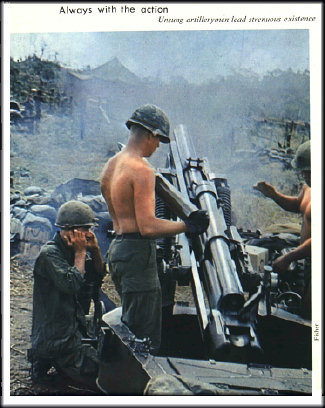
With the beginning of February
the Brigade terminated its three operations along the north central
coast with the following results:
Cochise/Dan
Sinh; 929 enemy dead and 1,987 suspects detained, 122.1 tons of rice
and 247 pounds of documents.
Bolling/Dan Hoa;
705 enemy dead and 2,398 suspects detained.
Walker; 272 enemy killed and Highway QL 19
secured.
Taking the place of the three
operations were Operations Lee Wainwright and Marshall.
Pg 2 - 7 |
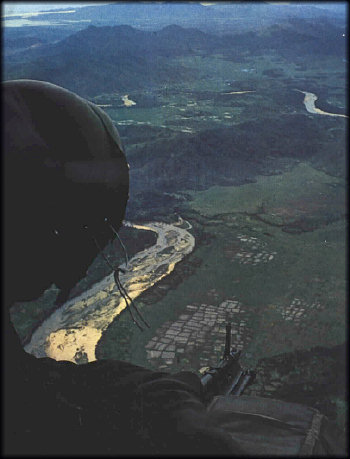
Helicopter Crew Chief
By Sp4 Adrian Acevedo
The man in the flying machine, and one of the true
professionals in the Vietnam War.
Clear left ! Clear right !
247, officially labeled a US
Army UH-IH Helicopter, but usually referred to as a "Slick" or
"Hotel Model", settles to the ground with a slight
bump.
Six passengers, including two Red Cross
girls and the Brigade Surgeon get off and go about their business at
Fire Support Base Shenandoah, temporary headquarters for the 2nd
Battalion, 503d Infantry.
Specialist 4 Juan
Collazo of Brooklyn, 247's Crew Chief, and Sp4 Pete Penner of
Greely, Co, the Door Gunner, meanwhile open the Pilots' doors and
slide back the protective armor so the two Warrant Officers can get
out.
A tall, thin 21-year-old with red hair
and freckles, Collazo then climbs on the ship and waits for the main
rotor to stop moving so he can push it down while Penner fastens it
to the tail. The Pilots wander off to find out what the ship's first
mission will be.
It could be almost any type
of mission, as 247 is the Command and Control ship for the 2/503d
today. "Usually," says Collazo, "its the reserve C&C for the
General", but like all the ships in the Casper Platoon of the 173d
Airborne Brigade, it can be expected to pull any type of mission on
any given day. Collazo keeps 247 in spotless condition, but the same
can be said of most Crew Chiefs since they all take tremendous pride
in their ships.
Penner and he are standing and
talking when a bedraggled Infantryman walks up and asks if the ship
is going back to the rear. "Yeah," says Collazo, "but not right
away, we have to find out what they want to do with us first. But,
we'll be going back sooner or later."
The
Infantryman shrugs and sets down his rucksack. "Say," he asks,
"weren't you the guys that set down to pick up those two casualties
we had a couple of days ago ? We were down in a valley and had
snipers up in the hills." "Yeah, that was us," admits Collazo,
pleased, as are all Crewmen when they learn the Infantrymen
appreciate their efforts. The trooper is a loquacious one, so they
continue to chat about life in Vietnam and things in
general.
Soon, however, Collazo is checking
his ship again, as he is wont to do countless times each day. His
diligence is rewarded when he finds a loose knob on the control
panel. The Pilots return at this time, so he asks where the control
was set at when it came off.
After he screws
it in place, the Pilots tell him Delta Company is going to be
extracted at 0900 and the Battalion XO will coordinate the move from
247.
They don't take off until 0930 however,
because the five extraction ships are late. 247 meets them over the
LZ and just circles while they move the Infantrymen six at a time
the two clicks back to the fire base. It is cold at the altitude, so
Collazo shrugs into a field jacket and stoically waits out the
boring hour and a half.
The rest of the day
proves to be relatively uneventful. The ship ferries several more
loads of passengers back and forth between LZ English and
Shenandoah, including the Red Cross girls and a man with a broken
arm. They also extract a wounded man from a Mike Strike Force
Company working with the Brigade and the body of a Viet Cong killed
by Bravo Company which is taken to the Government District
Headquarters.
The weather gets progressively
worse, however, and the ship has the misfortune to be at the Fire
Base when it is no longer possible to fly. The next day, the weather
is just as had and the Crew must remain another day at the Fire
Base.
On the third day the weather clears,
enabling 247 to continue its mission as the 2/503d Command and
Control ship. The end of the day finds Collazo, as usual, pulling
maintenance on 247.
Of course, these were not
topical days for a Helicopter Crew Chief. There are none, which is
probably one of the reasons Crew Chiefs like their job so
much.
According to Captain Stanley H.
Streicher of Cincinnati, Casper's Commanding Officer, several of his
Crew Chiefs have flown all day then worked on their ships until it
was time for them to pull guard. The next day after only a few hours
sleep, they are ready and willing to fly
again.
"My Crew Chiefs are a real professional
breed of men," declared Streicher. "With their dedication to their
ships and their missions and their extremely high morale they've got
to be the finest bunch of Crew Chiefs in
Vietnam."
Many feel that the Crew Chief is in
fact, the most important man in a Helicopter Crew since he is the
only one who accompanies the ship evervwhere it goes. The Pilots
work with the ships on a rotation basis and the Door Gunners are
changed frequently.
"You get to know your ship
so well," said Sp5 Bruce Neva of Kensal, ND, "that you can get more
out of it than anybody else. After a while, you learn all the tricks
about the chopper, so when something goes wrong, you know exactly
where to look to fix it."
There is an intense
rivalry among the Casper Crew Chiefs as to who has the best ship. "I
have the best ship," declared Neva, who waxes his Slick daily. But,
there are others who quickly dispute Neva's statement as they all
spend countless hours in maintenance to keep their choppers in top
condition. As Neva explained, "You have to like flying and you have
to like working on your ship to be a good Crew Chief."
Aids the Pilot
While in flight, the Crew
Chief's main job is to aid the Pilot in navigating by keeping him
informed of approaching aircraft and obstacles on landings and
takeoffs. He also supervises the loading when the ship is carrying
personnel or supplies to insure that it won't be so heavy as to
seriously damage the aircraft.
When air
assaulting Infantrymen into unsecure territory, it is also his job
to signal the men when it is time to leave the ship. And of course,
both he and the Door Gunner handle the M-60 machine guns which are
the Slick's only protection.
In addition to
these qualities, a man has to have an extra amount of courage to fly
Crew Chief on an OH-6A Light Observation Helicopter another type of
aircaft also flown by Casper. This small, extremely fast and
manueverable Helicopter is used mainly for reconnaissance missions.
But, with its minigun and the way it can approach the enemy without
warning, it can also be used in support of ground
forces.
The OH-6A Crew Chief's job while in
flight is to man the one M-60 machine gun carried on the ship, which
is where courage comes into the act. After a Loach nears the end of
a gun run and begins to pull out of it, the minigun can no longer
protect it, and it is very vulnerable to ground fire. Thus, only the
Crew Chief's courage and skill with the M-60 can save the ship from
being shot down.
On one mission, Bravo and
Charlie Companies of the 2nd Battalion were receiving heavy sniper
fire from a woodline between their positions. They couldn't reach
the enemy, so a Loach was called in to silence the snipers. In
addition to firing the minigun, Sp5 Rick Canning of Memphis, Tn, was
so effective at tossing out grenades, the Infantrymen asked later if
the ship was armed with rockets. "Nope," replied the Pilot, "that
was just my Crew Chief doing his job."
Love Loaches
Loach Crew Chiefs have as much
pride in their ships as those on Slicks. "I guess I just like the
way a Loach flys low and can sneak up on Charlie," said Sp5 Mike
Nuckols of Red Bluff, Ca "I remember one time when we caught one in
the open. He started to run, but there wasn't any place to hide, so
we just set down and I motioned him into the ship with a .45. He
turned out to be the son of a Viet Cong district
chief.
On a similar mission, Canning's ship
and another Loach were supporting armored vehicles which had trapped
a VC force against a large lake south of LZ Uplift. Several of the
enemy had boarded boats and were trying to escape across the
lake.
The Loaches just knocked the two boats
over with their rotor blast and made the VC hang on to their skids
while they ferried them one at a time to friendly forces waiting on
shore.
Another type of Crew Chief just as
dedicated as those in Casper are the men who crew the Gunships for
61st Assault Helicopter Company, which supports the Brigade out of
LZ English.
Sp5 Don Casella of Burbank,
Calif., explained that the 61st's UH-1C "Gunnies" are armed with
2.75 inch rockets and either two miniguns or a 40 mm grenade
launcher.
"The maintenance is much more
complicated on a Gunship than on a Slick," he said. "The Crew Chief
has to know the whole armament system, and it's a dual hydraulic
system instead of the single one the Slick has. It is just a
completely different ship with a lot more
maintenance."
"Despite the extra work,"
continued Casella, "I prefer crewing a Gunny to a Slick. Just guess
I'd rather do the shooting than get shot at."
As on a Loach, the Gunship Crew Chief mans an M-60 to protect the
ship when it pulls out of a run. And, as on a Slick, a Door Gunner
handles another machine gun on the other side of the ship. Both men
of course aid the Pilot by keeping him informed of approaching
aircraft and of obstacles on takeoffs and landings.
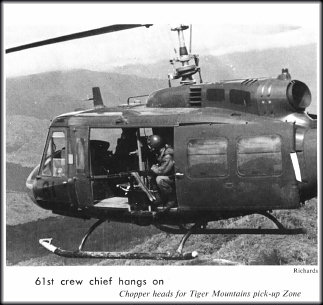 Most Crew Chiefs are young and are serving their
first tours in the Army, but their bravery, dedication and ability
to handle an emergency has proven beyond all doubt their worth in
Vietnam.
Most Crew Chiefs are young and are serving their
first tours in the Army, but their bravery, dedication and ability
to handle an emergency has proven beyond all doubt their worth in
Vietnam.
In one instance, Sp4 Gary Poland of
Sayreville, ND, a Loach Crew Chief from D Troop 2/lst Cavalry,
working with the 1st battalion, grabbed the ship's controls when the
Pilot was hit by enemy fire and blacked out. Poland pulled the ship
out of a dive and continued to fly it until the Pilot recovered
consciousness and was able to make a forced
landing.
Asked later how he did it, Poland who
had never had any flight training, grinned, "It really wasn't that
hard. I've spent a lot of time watching the Pilot
fly."
Maybe it really wasn't that hard, but,
there aren't too many people who could have done it. Except perhaps
another Crew Chief.
Pg 8 - 10 |
Sky Soldier of the Month
Sky Soldiers of the month for
the past quarter were Sp4 Mark A. Schneider of the 4th Battalion,
503d Infantry (December), Sp5 Guy William Streich of the 3d
Battalion, 319th Artillery (January), and Sgt Thomas Means of the
1st Battalion, 503d Infantry (February).
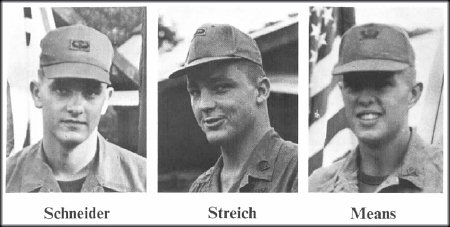 Sp4 Schneider of Charlie Company, 4/503d, began
his tour as a Pointman before becoming a Squad leader. Sp 5 Streich
is a field artillery operations and intelligence specialist with
Delta Battery, 3/319th and Means an Infantryman with Delta Company,
1/503d.
Sp4 Schneider of Charlie Company, 4/503d, began
his tour as a Pointman before becoming a Squad leader. Sp 5 Streich
is a field artillery operations and intelligence specialist with
Delta Battery, 3/319th and Means an Infantryman with Delta Company,
1/503d.
All three Paratroopers were selected
by the Sky Soldier Executive Board on the basis of their knowledge
of military duties and regulations. In addition to a Sky Soldier
plaque they also received a one week R&R to the city of their
choice, a 50-dollar cash award and spent a day as special aide to
the Commanding General.
An indication of the
high quality Soldiers these men are, was a comment by Sp4 Schneider
concerning his tour in Vietnam with the Brigade. Said Schneider: "My
duties here have taught me the importance of making decisions
accurately and making them quickly under fire, the right decision
made in a microsecond can mean the difference between life and death
for both you and your men. I seriously feel that my tour here is
benefitting me in that upon my return to the world, I will be ready
and eager to face the decisions and responsibilities life offers
there."
Olive Drab in Color
TOWEL - Olive drab, an Army
issued item for use after bathing.
Designed
for the Vietnam Soldier with the idea of camouflage in mind, these
dark green towels were probably never considered for the multiple of
practical uses the Infantry now finds for them, the least of which
is bathing.
In the 173d Airborne Brigade,
Infantry Paratroopers find little opportunity for bathing in the
jungle, but their olive drab towels nevertheless remain treasured
items.
"It's best for perspiration," declared
one Paratrooper who wears a towel slung around his neck ready to
wipe off the sweat as his Platoon trudges up and down mountain
slopes.
Others tuck one green end beneath
their helmets and drape the towel across their rucksacks to protect
their exposed necks from the direct rays of the sun, and as a
partial cover for rain.
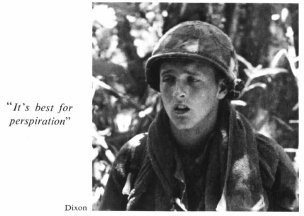 Of all the Infantrymen, however, the machine
gunner gets the most use from his towel and usually tries to have an
extra two or three on hand.
Of all the Infantrymen, however, the machine
gunner gets the most use from his towel and usually tries to have an
extra two or three on hand.
The majority of
machine gunners will use their towels to cover their most vital
weapon from the constant companion of moisture. Some also wrap the
gun straps to help prevent the heavy load from digging too greatly
into their shoulders.
The machine gunners as
well as other line Soldiers also maintain a special towel for
cleaning purposes on their gun.
Once bedded
down at night, other towels appear from the soldier's rucksack and
neatly folded will convert into the next best thing to a pillow.
Pg 11 |
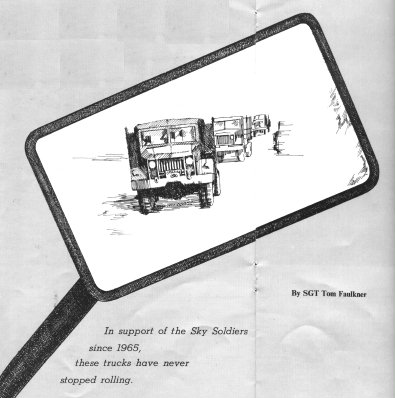
Airborne
Express
Emerging from the churning
clouds of red dust, the headlights from the heavily laden convoy
quivered from the rough, pockmarked mountain
road.
A welcome sight to any Sky Soldier of
the 173d Airborne Brigade, the truckers of the Airborne Express were
rumbling toward the forward elements, bringing food, water and
ammunition.
For the truck drivers, it was
nearly the end of another unsung, dirty, bone jarring day, which
began back n the spring of 1965 at Vung Tau continued through the
unforgettable struggle at Dak To and into today's Brigade operations
along South Vietnam's north central coast.
Hauling everything to include the kitchen sink, the Airborne
Transportation Platoon, Company C (S&S), 173d Support Battalion,
better known as the Airborne Express, has supported the nomadic
Paratroopers in more than 20 separate locations with as little as
24-hour notice.
"We are currently supporting
the Brigade in four areas," said 1Lt John Henry Girard, a Platoon
Leader from Santa Ana, Ca, who notes that in addition to hauling all
supplies and equipment for the Brigade, the Airborne Express has the
monumental task of supporting all units attached to the
173d.
"We provide support for three times as
many men as our original commitment," remarked Captain Lewis B.
Sanchez, C Company Commander, "and the size of the Transportation
Platoon has certainly not increased
proportionately."
"If it can be hauled by
truck, we'll haul it," Platoon Sergeant Jack D. Potter said proudly.
"We're on call day and night. Our men respect the role of the
Infantryman and we'll do all we can to help him out
"
A good indication of the truckers' fortitude
was one particular operation last summer in support of the 4th
Battalion in the mountains northwest of Tuy Hoa, when the Airborne
Express was put to a test of driving skill and determination.
Operating near Dong Tre, a small village that had been harrassed by
VC, the 4th Battalion was in daily need of resupply, and trucks
bearing the Airborne Express license plate became a familiar sight
to the villagers along that stretch of twisting, turning,
crater-ridden road.
Recalling his many trips,
Sp4 Donnie G Hurd of Bridgeton, Mo. said, "We drove that road so
many times, all you could hear when we passed through the villages
was the children shouting, "Airborne Express." But, the villagers
weren't the only ones who became familiar with the frequently
traveled route. The Viet Cong had been watching too. Time after
time, the VC tried to stop the convoys with sniper fire and mines,
but the trucks continued to roll. "It was hard enough to control the
trucks on that open road," said Sp4 Dewitt T. Rule of Toms River,
N.J. but when the VC opened up on us, the only thing we could do was
shift gears, step on the gas, and pray, especially if you were
hauling fuel or ammunition."
During the
operatioin, the Airborne Express hauled over 90,000 gallons of
highly flammable JP4, 100 tons of ammunition and several tons of
food and expendables to the 4th Battalion, two ARVN battalions and
D/16th Armor. No supplies were ever lost.
Although the VC were unable to prevent resupply, the tough road
conditions did take its toll on the vehicles. On numerous occasions
darkness would fall before the drivers could push their ailing
vehicles into the motor pool at Tuy Hoa. Everything from bleeding
oil pans to flat tires and bullet holes had to be repaired, and the
early morning hours would often find the drivers still working to
ready the trucks for the next convoy at 0600 hours. "That road was
so bad, you felt your insides were coming apart," remarked Sp4 Rule,
who is now on his second tour in Vietnam. "If it was that bad on the
drivers, you know the trucks were taking a
beating."
According to Captain Sanchez, the
Transportation Platoon is one of the best organized and maintained
units in Vietnam. He pointed out quite accurately; "Their ability to
react to a situation and perform well under adverse conditions has
proved them extremely valuable to the Brigade's
missions."
Ability to react and organize was
displayed recently when SSG Potter was notified that an unexpected
shipload of beer and soda had arrived in Qui Nhon for the 173d. A
shortage of men and trucks did not prevent completion of the
mission. In two days time, extra drivers were trained, licenses
issued, maintenance performed and trucks on the road. "The monsoon
rains didn't help matters," recalled Potter of Cleveland, Tx, "but
everyone worked together and we made it on schedule. That's one load
that the troops look forward to."
Monsoon
rains and VC attacks have not kept the Airborne Express from
completing more than 250 long hauls, weighing over 5,000 tons in the
past three months. Of the 46 men assigned to the Platoon,
approximately 75 % are on the road daily.
Each
of the 14 five-ton, and 21 two and a half ton trucks proudly display
a blue plate on the front of their bumper. Drawn in gold letters are
the words, Airborne Express, and a straight razor suspended from a
parachute. The razor symbolizes sharp, clean-cut drivers with a high
degree of professionalism while the parachute speaks for itself.
Proof of the razor-sharp image lies in the fact of the many awards
that the men of the Platoon have received. "There is never a dull
moment," quipped SSG Potter, "but, when the going gets rough, we
just take two salt tablets and "Drive On."
Pg 12 - 13 |
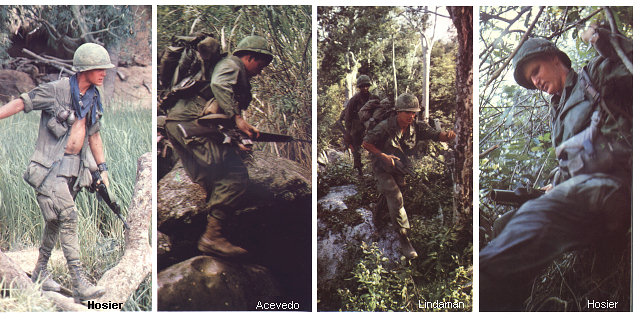
They Walk Where Others Fear to Tread . . . .
It was precisely 0935 hours. Clear, 81
degrees.
A tall broad-shouldered man with the
4th Battalion, 503d Infantry slowed to a stop as he approached the
thickly vegetated ravine. He unsheathed his machette and moved
forward again, hacking viciously at the tangled clump of vines
blocking his path. Beads of sweat swelled beneath the band of his
helmet.
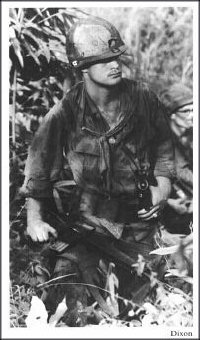 More than 100 miles to the north,
another figure, a wiry, black-haired Italian from Trenton, N.J. was
crouching low in the swaying elephant grass, his rucksack, more than
half his weight, pushing heavily against his shoulders. As the rest
of his Platoon from the 1st Battalion, 503d Infantry approached, he
pointed out the well camouflaged Viet Cong booby trap to each man,
and they moved around it quietly. More than 100 miles to the north,
another figure, a wiry, black-haired Italian from Trenton, N.J. was
crouching low in the swaying elephant grass, his rucksack, more than
half his weight, pushing heavily against his shoulders. As the rest
of his Platoon from the 1st Battalion, 503d Infantry approached, he
pointed out the well camouflaged Viet Cong booby trap to each man,
and they moved around it quietly.
For both of
these men, it was a familiar scene in a typical day pulling point
for the 173d Airborne Brigade a day filled with constant tension,
muscular strain and the realization that one mistake could bring an
abrupt end to both themselves and the Squad or Platoon behind
them.
In appearance, the Pointman looks just
the same as the Infantrymen who follow him, except perhaps if one
takes a closer look and notices the hands, scarred by cuts and
bruises left by breaking trails through the thick and thorny brush,
or the fact that he's just a bit more lean because he sometimes has
to walk twice as far as the rest of the
Platoon.
Often the Pointman will struggle up a
mountainside only to find the terrain impassable, forcing him to
return and find an alternate direction.
When
the Company breaks for chow, he is the last to eat. First he must
move ahead to find the best route for the Platoon to take. He is
then, of course, the first to move out again.
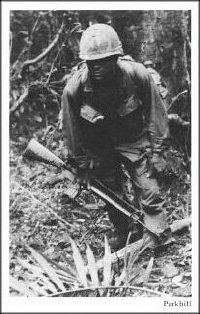
"I look for four things in a
good Pointman," said 1Lt Rand Shotwell of Dallas, Tx, who has been a
Platoon Leader with both the 4th and 2nd Battalions. "He must have
intelligence, mental alertness, good physical condition and guts, a
lot of guts." "A good Pointman," added SSG Thomas H. Hubbard of
Jonesboro, Tn, 1Lt Shotwell's Platoon Sergeant with Bravo Company,
2/503d, "will usually mean the difference whether you surprise
Charlie, or he surprises you." It isn't surprising to find out the
job is an easy one to get. Often all a man has to do is volunteer.
"Usually," said 1Lt Abner Harrell of Brunswick, Ga, "only the better
men volunteer. They know the task, have confidence in themselves and
want to help the Platoon."
"I walked point for
six months before I became a Squad Leader," said Sgt Ronald R. Brown
of Albany, Ga "and I'd say the main thing to remember is not to take
Charlie for granted. Just when you think you have him figured out,
he'll change his tactics. A Pointman must be alert every minute."
Concurring, Sp4 Gary L. Seavers of Azores, Portugal, Pointman with
Delta Company, 2/503d added; "You may go for weeks without making
any significant contact, but Charlie will always be watching you.
He'll watch and wait, hoping that we'll become lax or overconfident.
All you have to do is stay alert and dont' give him any
slack."
Frequently, Companies and Platoons
will utilize a two Pointman system. The first man in file will break
the brush and the second will look for snipers. When moving in open
areas, the first man will check for booby traps. Sp4 Seavers
explained, "Two men on the point works out pretty well, when we are
in the thick bush, you don't need to worry about booby traps too
much for if Charlie had been through the area, there would likely be
a trail of some sort." With the invention of more ingenious booby
traps, two men on point has proven more effective. The first
concentrates only on booby traps and lets the second worry about
snipers.
Every Pointman has his own techniques
to keep his men as well as himself alive. He utilizes past
experience, takes advice from the oldtimers and receives a lot of
help from the Kit Carson Scouts. "You look for anything out of the
ordinary," said Seavers, "like a vine across a trail in an area
where there are no vines growing.
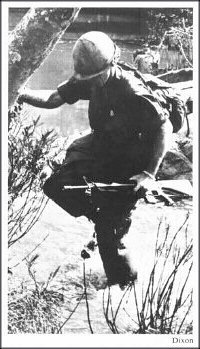
Recalling a situation which
happened to Alpha Company, 2/503d, PFC Martin J. Waters of Malta,
Montana said, "We had been operating in the highlands and were
ambushed every day for seven days. I was moving about 20 to 25
meters in front of the Platoon, and I would hear a clacking noise.
Shortly afterwards we would get hit. We found out that Charlie was
communicatillg by clacking bamboo sticks together. After the first
ambush, each time I heard the noise, I knew what was coming and
warned the Platoon.
Being the first man to
walk into an unknown area can get a bit nerve racking at times, but
there are some Pointmen who wouldn't take any other job. "I like
walking point, mainly because I gain confidence in myself and depend
on myself to find booby traps or ambushes," asserted PFC Steve M.
McCandless of Camden, N.J. who walks point for Delta Company, 2nd
Battalion.
Others, like Sergeant Brown, have
less lofty reasons for taking the precarious job. "I was an RTO
before taking over on point, and I definitely prefer the latter. It
might be more dangerous, but you don't have to hump that radio."
Despite their difference in techniques or motivation, there is,
however, one thing they all agree on about the
job.
As McCandless summed it up: "Never become
overconfident. If you are as cautious and alert your last day in the
field as you are your first, then you'll make it and probably keep a
lot of guys from getting blown away."
Pg 14 - 16 |
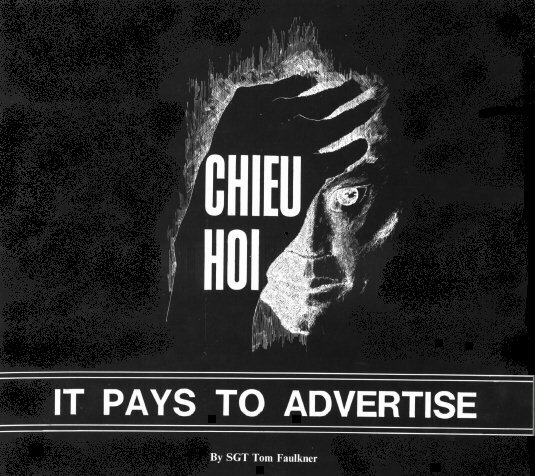
The Madison Avenue wizards of
advertising should take a close look at the Chieu Hoi campaign being
conducted by the 173D Airborne Brigade.
Clad
not in greyflannel suites but in jungle fatigues, armed not with
fast talk and hard sell but paper bombs and words of TNT which
explode not with low prices and hot specials but with words of truth
and hope for a better life. The Paratroopes of the 173d Civic Action
Office and a team from the 8th Psychological Battalion wage a
relentless war against Communist agression.
To
sell a product, the ad man must get his message to his audience and
the 173d has exposed over one million villagers, Viet Cong and North
Vietnamese Army troops to the Chieu Hoi program in the provinces
along South Vietnam's north central coast.
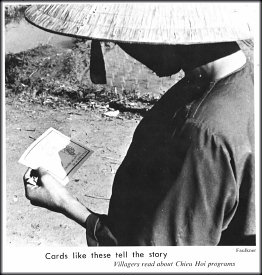 A typical scene is the Viet Cong crouching in the
tall elephant grass or a village farmer trotting methodically behind
his beasts of burden on a daily trek to the rice fields, while a
shower of leaflets fall at their feet.
A typical scene is the Viet Cong crouching in the
tall elephant grass or a village farmer trotting methodically behind
his beasts of burden on a daily trek to the rice fields, while a
shower of leaflets fall at their feet.
Trucks
armed with loudspeakers spread the message of CHIEU HOI from the
market places to the secluded
hamlets.
Suspended from a blimp, 1500 feet
above the Brigade's forward command post in the heart of this area,
a massive leaflet has exhibited the words CHIEU HOI in bright red
seven foot high letters which can be seen for over a mile in any
direction.
The 173d has reached the masses
through leaflets, loudspeakers, posters, cigarette and candy
wrappers. To the Vietnamese, Chieu Hoi has become a household word,
an ad mans dream.
But what does Chieu Hoi mean
and what is the program? Chieu Hoi literally translated means
"Joyful Return" but it means much more to the VC/NVA and the South
Vietnamese.
To these people it means that the
Vietnamese Government welcomes back to society those soldiers and
workers who have been misled by Communist propaganda or have been
forced into the Communist camp through no choice of their
own.
In short, the program offers members of
the opposing side an invitation to come over to the Government of
Vietnam, return to their homes and loved ones and become useful and
loyal citizens.
The brains behind the CHIEU
HOI program in the 173d Airborne Brigade belongs to Major Ronald A.
Lawrence of Normal, Il, the chief of the Civic Action
Office.
A veteran of three years in Vietnam,
Major Lawrence has an uncanny insight into the Vietnamese problems
and their mode of life and has established a fantastic rapport with
the people.
According to Major Lawrence, the
intent of the CHIEU HOI program is to induce those who are giving
military and political support to the VC/NVA to come over to the
side of the Government of Vietnam and hence cripple the enemy
movement through the loss of soldiers, weapons and civilian support
which in turn strengthens the US and GVN forces. In addition to this
physical loss, the program also chips away at the organizational
structure of the National Liberation Front and lowers the morale of
the VC/NVA by attempting to kindle dissension and distrust among
their members.
Ideas Revamped
It wasn't too long ago when
CHIEU HOI literature was bolder and stressed our military
superiority, and that VC/NVA resistance was useless. This, however,
was found to induce animosity among the enemy forces and intensify
their resistance.
So, like any good ad man
whose product isn't selling, the program directors changed their
pitch. Now the theme emphasizes the family bond, appealing to the
Communist soldier to come home and be again with his family. The
results have been encouraging.
In an
advertising campaign, serious consideration must be given to the
area being covered and the population. As for the 173d Airborne
Brigade, it has the dubious opportunity of operating primarily in
the rice rich Binh Dinh Province, one of the most densely populated
in Vietnam and until recently a Viet Cong
stronghold.
Working closely with their
Vietnamese counterparts in the program, the Brigade has used the
incentive technique, often used in the advertising field, and
instrumental in producing a record number of Hoi Chanh's or
"returnees" in the past year.
Given Money
Once returned, a Hoi Chanh is
given a sum of money for returning, and an additional sum if he
brings a weapon. He is given free housing at the Chieu Hoi center
and enough money to defray clothing and food expenses. After he has
been informed of the goals of the United States and Vietnamese
Governments, he is often times given vocational
training.
1st Lieutenant Robert E. White of
the 8th Psyops Team, working closely with the Brigade is responsible
for leaflet distribution and loudspeaker
broadcasts.
"Once we receive a Hoi Chanh,
every effort is made to obtain all of the information he may possess
about the enemy," said 1LT White of Cedar Hill, Tennessee. He put
aside one of the new CHIEU HOI leaflets and added, "Information from
Hoi Chanhs have provided us with the enemy's unit size, supply
routes, morale problems, caches of weapons and food, infiltration
routes and methods of communication."
One of
the best and most successful advertising tools is the personal
experience approach which has been utilized with good results by the
Brigade. "The best example of the personal experience approach is
one of our most recent and most cooperative Hoi Chanhs", explained
White. "She came to us from a VC platoon which is led by her fiance,
and she gave us names and locations of the unit. According to 1Lt
Whites, a voice tape was made, on which she pleaded with her former
comrades to return and her picture was attached to a leaflet in her
handwriting. The recording will be played and the leaflets dropped
in the areas that she had designated. Although only an isolated
case, she was among the thousands that have returned in the past
year. Over 12,000 VC / NVA have returned to the
Government of Vietnam in
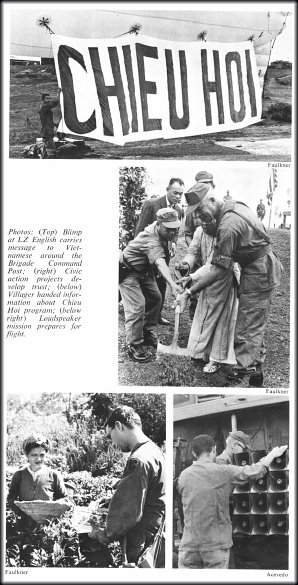 1968 and more
than 87,000 since 1963. 1968 and more
than 87,000 since 1963.
For a period of six
months after returning to the Government of Vietnam, a male Hoi
Chanh is exempt from the ARVN draft. Major Lawrence explains that
there are several other choices open to the Hoi Chanh who is
eligible for the draft.
Kit Carsons
He points out, "The 173d has
adopted the Kit Carson program and Hoi Chanhs are employed to work
with the Brigade Paratroopers. These men serve as scouts and have
been invaluable as guides and leading troops to VC areas of
operation, since they have usually worked in the areas while with
the enemy."
Many returnees, after their
release from the Chieu Hoi Center will join the ARVN even before the
six month draft exemption expires. Some of the more articulate and
competent returnees are permitted to join armed propaganda teams.
Moving through the countryside, the teams inform the people of their
past association with the enemy and advise them not to make the same
mistake.
And, there are those Hoi Chanhs who
are too young or too old for the military and cannot qualify for the
APT. These people return to their families and
farms.
Results are what makes a successful
advertising campaign and the CHIEU HOI program has proved itself by
producing an increase each year in the number of Hoi Chanhs. Today
one might say, there are, 87,000 fewer VC/NVA soldiers fighting
against 173d Paratroopers and their allies.
It
costs slightly more than three hundred dollars to provide for the
housing, food, clothing and training for a Hoi Chanh. Compared to
the cost of finding him and destroying him as the enemy, three
hundred dollars is negligible. The 173d Airborne Brigade is proving
the old adage in Vietnam, "It Pays to Advertise".
Pg 17 - 19 |
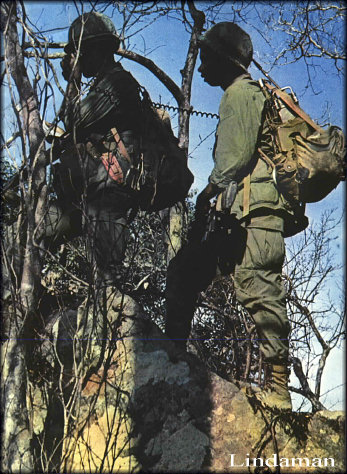
Radio-Telephone Operator
Man with the SoundBy Sgt Tom Faulkner
His weapon operates on batteries
and he doesn't have to fire a shot to wipe out an enemy position.
Sometimes you say he's "gettin over" and other times you wouldn't
take his job for another R&R.
Courage,
intelligence and a cool head are all essential and he can make or
break a Platoon Leader or Company Commander. When you are hit, he
calls for Dustoff and if you are pinned down he can bring the wrath
of gunships and artillery to the rescue. Chow, clothing and those
little extras like writing paper,soap and cigarettes are at his
beckoned call.
He is a
radio-telephone-operator (RTO) and frequently your only contact with
other elements.
"I choose an RTO based on his
intelligence and ability to express himself," said Captain James M.
Grimshaw, Delta Company Commander, 2nd Battalion, 503d Infantry. He
also must be mentally alert, level-headed and familar with radio
procedure."
Captain Grimshaw paused and puffed
on his cigar. Then he added,"An RTO has got to have a good supply of
confidence and be capable of making decisions on his own. There may
be a time when he has to take over a Platoon or even a Company
."
Lieutenant Larry T. Leray of Tibodaux, La,
Platoon Leader with Bravo Company, 2nd Battalion agreed
wholeheartedly. "I want my RTO to be able to act without being
told," said Leray. "I've had some terrific RTO's who often knew what
I was thinking even before I did."
The problem
though, is finding the right men. "It's almost like some of these
guys were born with a radio in his hands," said one Company
Commander. "I've seen some who pick up radios like a fish taking to
water. Others just haven't got what it takes. "
Extra Load
In addition to the
responsibilities, an RTO has an extra heavy load to carry. A
25-pound radio, extra batteries, sleeping gear and as much as six
days rations can sometimes be quite a hassle, especially when trying
to maintain the same pace as his CO or Platoon
Leader.
"It's really rough when you're in the
mud or thick brush," declared Pfc Terry L. Evans of Tampa, Fla, an
RTO with Delta Company, 2nd Battalion. "In the bush, the
wait-a-minute vines grab your aerial and the mud just seems to keep
pulling down."
Recalling his last ten months
with Delta Company as the Company Commander's RTO, Sgt Edward P.
Fruchtenicht of Portola, Ca said, "Sometimes I think I was chosen as
an RTO because I was the biggest guy in the Company and they figured
the extra weight wouldn't bother me.
"But I
wouldn't have traded it for any other job," added the husky
Californian with a smile. "As an RTO you feel like an integral part
of the Company and nothing happens out there that you don't know
about."
The duties of the RTO will vary
slightly even within Companies, but what he is expected to know and
carry is the same. Some merely answer calls and pass the horn to the
Platoon Leader or Forward Observer. Others are expected to maket
some of the minor decisions that a Commander would have to
make.
"After an RTO and I have worked together
for awhile, we learn how each other thinks and reacts to a
particular situations," said 1Lt Leray. "I depend on him to take
care of a lot of problems such as calling in our location status,
leaving me more time to concentrate on the Platoon and tactical
problems," said Lt. Leray.
Although the RTO's
main function is to maintain constant communication with the Company
Commander and the other elements, a good RTO is also aware of the
job of each man in the Company. On many occasions, he will have to
fill in for a Machine Gunner or even a Medic.
"We were walking through a rice paddy when Charlie sprung an ambush
on our point element," remarked Pfc Martin J. Waters, of Alpha
Company, 2nd Battalion. "The Medic had his hands full, so I ran
forward and was able to patch up one of the men, while calling in a
Dustoff. "
As in any job, the first few days
are the roughest for an RTO. He must learn how his Commander
operates adjust to the weight of his rucksack and most of all learn
the call signs.
"My first few days were a real
horror show," recalled SGT Fruchtenicht. "You've got to keep that
handset to your ear at all times and sometimes use as many as ten
different call signs. It gets complicated and there is no room for
error."
Hazardous Job
"One thing I found out real
quick when I became an RTO," said Pfc Waters of Malta, Montana, "was
that your aerial makes a pretty good target for the VC. I caught two
rounds right through the radio my first week in the field. An RTO's
position in a column couldn't be more conspicuous if he wore white
fatigues."
However, despite the hazards,
hassles and added responsibilities of the job, most RTO's in the
173d Airborne Brigade seem to take a special pride in their
jobs.
"I've humped the radio for more than
nine months," said Sp4 Paul R. Lash with the Recon Squad of B
Company, 2nd Battalion, "and I wouldn't want any other job over
here. The extra weight and responsibilities are compensated for by
always knowing what is going on and being able to personally help
the troops. And besides, it is not all that dangerous.
"
The job of the RTO remains the most
complicated of all combat assignments and although Commanders know
what they look for in an RTO it is difficult to define all the
virtues that make-up a good one. He is a prime target for the enemy
and often is responsible for life and death, success or failure,
victory or defeat.
Perhaps one of his most
difficult battles is with man's basic instinct, that of
self-preservation, for when the hot lead starts flying he must reach
for his radio, not for his rifle.
Pg 20 - 21 |
|
Protecting Vital Highway QL 19 and An Khe
against repeated threats form NVA/VC ambush and sabotage is no easy
chore, but it has been shouldered by the Infantrymen of the 1st
Battalion (Mechanized) 50th Infantry with devastating success since
August 1968. Pictured here 1/50th APC's rout an NVA ambush
site.
Photos by Sp4 Craig Lindamann.
|
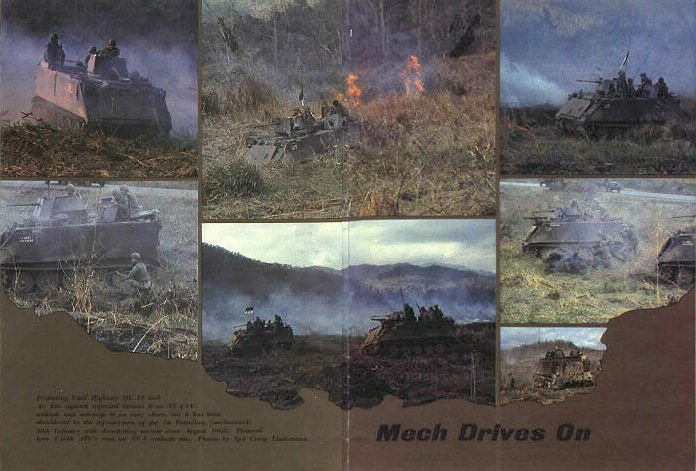
Pg 22 - 23 |
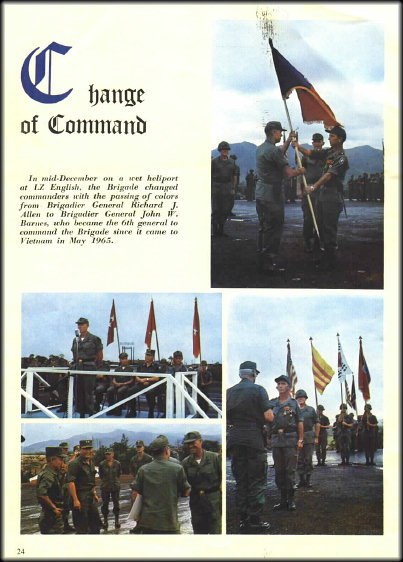
Pg 24 |
Nothing too Good for HimBy 1Lt John Emmert
The afternoon of the fourth day,
Alpha Company, 1/503d Infantry, was moving into its laager site
after a three-click trek across two ridge lines. Though the load was
lightened of C-rations and ammunition spent up in two contacts with
the enemy, the troopers felt exhausted. Movement had been
particularly difficult and the Company hadbeen breaking brush most
of the way.
As their day of patrolling came to
an end, men of the 1st Battalion's Forward Aerial Supply Team (FAST)
moved into the last phase of resupply.
"Two Whisky. One Whiskey,
over"
"Two Whiskey. Go"
"This is 1 Whiskey, Roger. Lucky Star
624
just departed my location inbound to Kilo 8 Alpha
with
their Romeo Sierra.
Is Kilo 8 Alpha on our push?"
This is 2
Whiskey, Roger. He is up and waiting, Out"
Anticipation was mounting for the Infantrymen who had just finished
cutting an LZ while the Company Commander radioed the chopper its
clearance to land. Resupply, which can be carried out at any time in
the day, meant mail from home, possibly a hot meal, change of
clothes, ammunition and a sundry pack. There would be a myriad of
other things too, that often an Infantryman takes for granted-
water, medical supplies, ponchos, air mattresses, and maybe a
repaired weapon. Nearly all that had been requested the day before
by "firefly" had arrived. Every Company in the field gets resupplied
in this manner. The "firefly" begins with the Infantryman and is
passed through the chain of command to the Company CP where it is
logged and radioed in code to the Battalion trains area. The list
includes everything the men think they will need to operate until
the next resupply.
Conceived by Captain David
Cooper, 1st Battalion S-4, the FAST system is comprised of a team
chief and two men per Line Company who have undergone training to
insure efficient operation supply. Classes, given by the S-4
personnel, cover expendable items, stockage levels, supply location
points, and the handling of critical supplies. Similar classes
conducted by men of the Battalion Ammunition Point are designed to
brief the team on ammo resupply. The team was also trained in
loading "Chinooks" and "Hueys."
"As a result
of this training," says Sergeant James Rhatigan, resupply team
chief, "resupply days are not the hassle they once were. With a team
member aware of Battalion needs and capacities as well as the
requirements of his Company resupply under the FAST system
inevitably favors both levels." "The team enhances professionalism,"
he added, "and its sole purpose is to support our forward elements
as completely, efficiently and rapidly as
possible."
In the other Battalions of the
Brigade, resupply operations are similar. Flow charts and records
are constantly reviewed, updated and changed at Battalion and
Brigade S-4 level to keep the machinery of supply working smoothly
and efficiently.
New supplies, however, are
only part of the picture. A broken weapon in the field means to the
Infantryman that, more than likely, he will have another one on the
next resupply. It also means a great amount of work for the
Battalion maintenance teams who are ready to repair radios,
vehicles, weapons and other equipment, or if the damage is too
great, send the work to the next higher maintenance
echelon.
The supply chain begins at the
Company where the ammunition and supplies are passed out to the
individual Infantrymen. The next link in the chain is the Battalion
S-4 who maintains the LOC and is responsible for stocking and moving
the supplies, usually in coordination with the Brigade Aviation
Office, to the Companies. From there, the supply picture gets quite
a bit more complicated. Items like food, fuel, ammunition and
perishables can be drawn directly from 1st Logistics Command forward
supply points set up across Vietnam near the operational units.
Repair parts are stocked by every unit from Company to Brigade
level. The Brigade Maintenance Office in An Khe faces tasks involved
in keeping machinery and equipment operational.
Brigade supply requests have deep roots. Over
95% of all supply items are obtained through Qui Nhon depots and
nearly all of their supplies are from ports like Okinawa, Japan,
Hawaii and the US mainland.
The meaning of a
good supply system is fundamental, says Major Joseph T.Gill Jr,
Brigade S-4 Officer. "Whether ammunition or typewriters, sundry
packs or soda, good supply means a high spirited a combat effective
fighting force. No army in the world has ever been as well supplied
as the US Army. And, no other Army of the United States has been as
well supplied as the fighting men in Vietnam."
Pg 25 |
Chaplains find new generation of free thinking, morally
enlightened men.By Sp4 Larry Gillis
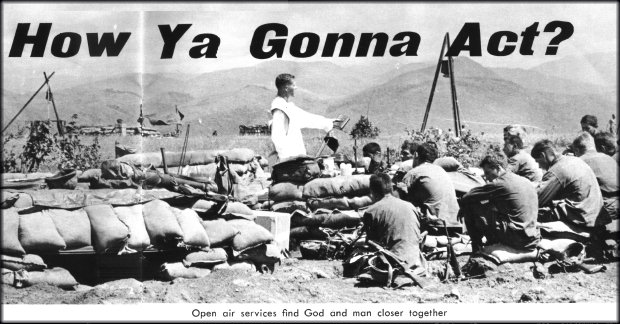 Chaplain Davis conducts daily mass for
troops. Chaplain Davis conducts daily mass for
troops.
The morning hush was abruptly
intruded by the sound of an approaching helicopter. The dewslicked
vines on the vegetated hillside waved like a frenzied dance troupe
as the bug-like chopper slipped over the treetops and touched down
on the tiny carved-out clearing that served as a landing
zone.
Two figures climbed from the chopper and
strode toward the laager site, home of some Paratroopers from the
173d Airborne Brigade.
"Hey! Is it Sunday
already?" croaked one Sky Soldier with a deep, sleep-soaked voice.
"No, it's Thursday," said one of the advancing
figures.
"Then what are you doing here
Chaplain Kelly'?'' returned the Paratrooper as he emptied another
envelope of sugar into his coffee. "Couldn't make it out to you guys
on Sunday for services, and if anyone needs religion, it's this
outfit," quipped Chaplain (Captain) Lawrence
Kelly.
"Aw, how ya gonna act Sir?" said the
sleepy Paratrooper with a wide grin.
Chaplain
Kelly heard the young Soldier's answer and only grinned in return.
He understood that it didn't mean anything disrespectful. In the
jargon of the soldier in Vietnam, expressions like, "How ya gonna
act?" pop up all the time. To most Sky Soldiers, "How ya gonna
act?", is a convenient phrase to fill conversational lulls. But, for
the Chaplains of the Brigade, this curious bit of slang has come to
have a special meaning.
"We have a generation
of young men today," explained the redheaded Chaplain, "who want to
cut to the bone of modern day problems. Young boys become young men
overnight. All it takes is the flight from the States to Vietnam. "
New Generation
Chaplain Kelly further added
that the expression, "How ya gonna act?" is important and an
indication of modern morality. It shows that today's Soldier is more
concerned than ever about how he reacts to the world he is part of.
I think it is a wonderful sign for the
future."
Many of the other Brigade Chaplains
were in full agreement with Chaplain Kelly. "I'm especial impressed
with today's Soldier," asserted one Chaplain. "He is a much more
pragmatic individual than Soldiers I have known in the past. He
isn't afraid to speak his mind, and he looks at things clearly. He
tries to determine right from wrong in the complexities of today's
world. This phrase, "How ya gonna act?' is very indicative of the
way he thinks - a sort of situational ethics. Every day certain
situations confront us, and the way we act determines what sort of
person we become. "
However, as Chaplain Milan
Mulac, who immigrated to the U.S. from Yugoslavia pointed out,
despite many changes in modern morality and ethics, relationships
between men of the cloth and men of arms haven't changed much
through the Centuries.
"There has always been
a close relationship Father Mulac said. "I suppose it started back
in the crusades, when bishops and priests were often seen leading
men into the rage of battle to retrieve beleagured Jerusalem from
the Moslem infidels."
Indeed, the Clergyman's
importance has not diminished with the passing of centuries of armed
conflict. During America's embryonic days, men of God played a
decisive role in tending to the spiritual needs of the Revolutionary
War patriots. Chaplains upheld the same heroic tradition in both
World Wars and in the Korean conflict.
"We
still have the same basic and formidable role," said Chaplain (LTC)
C. Howard McCloy, Sr., who recently took over as Brigade Chaplain.
"There is still the great need of bringing men to God and God to
men."
But, despite continued closeness between
the two groups, Chaplain Kelly claims that the adage about no
athiests in a foxhole doesn't always hold water in Vietnam. "Today's
young men have a healthy questioning attitude," asserted Chaplain
(Father) Kenneth Gilley, " we can't use the old scare philosophy
with religion. It doesn't work. These men are interested in the
nitty gritty. They are better educated than ever before and more
morally aware than previous generations. They want to help solve
problems."
Chaplains should spend as much of
their time as possible with the men," said Chaplain Kelly. And spend
they do, statistics from their recent quarterly activity report show
6,831 visits to Sky Soldiers throughout their areas of operation.
Almost half of these visits were to the troopers in the field or
forward areas.
"John Wesley, the founder of
the Methodist Church, used to say that the world was his parish,"
explained Chaplain Kelly. "The same is true for an Army Chaplain.
Any place in the world could be his parish."
Worldwide, the Army has more than 1,200 Chaplains. Ideally, there
should be one Chaplain for every 800 men, but the shortage is
critical. Each Chaplain is a college graduate, and has at least
three years of graduate school. In addition, they are all graduates
of the Army Chaplain School at Fort Hamilton, NY, where they are
intensively trained for 12 weeks in Army organization techniques,
military courtesy and military tactics. Upon graduation, he is
commissioned to the rank of Captain. All six of the Brigade's
Chaplains are Airborne qualified.
Besides
ministering to the Paratroopers, the Brigade Chaplains are also
deeply involved in community projects. With funds from an all
denominational collection, the Chaplains along with the Brigade
Civic Action Office supported a Catholic orphanage at An Khe, and
donated to help rebuild a Buddhist temple near Bong Son. Community
projects are joint efforts with all faiths represented in the
Brigade pitching in what they can.
Chaplain
Mulac lucidly explained the primary responsibility of the Army's men
of cloth. It's up to us to show the men that the Army does care
about their spiritual and moral well being. Sometimes for the
Paratrooper kneeling in mud or seeing a close friend get hit, it is
hard to believe, but we try our best to ease the burden.
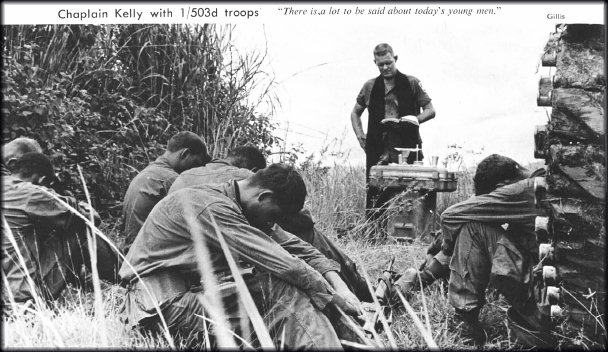 The Chaplains prefer to earn
rather than demand respect from the men. "To do this, you must
approach the men realistically," said Chaplain Kelly. If Chaplain
Kelly happens to be nearby when a Paratrooper lets out with cussing
and swearing that Paratroopers sometimes tend to do, he bellows,
"HEY GARBAGE MOUTH!", and it's usually enough to end the most
colorful tirade of adjectives. "The men can respect a man who treats
them like a man," said one Company Commander. "Don't forget, these
men are doing a tough job. Fancy lectures fall on deaf ears in the
boonies." The Chaplains prefer to earn
rather than demand respect from the men. "To do this, you must
approach the men realistically," said Chaplain Kelly. If Chaplain
Kelly happens to be nearby when a Paratrooper lets out with cussing
and swearing that Paratroopers sometimes tend to do, he bellows,
"HEY GARBAGE MOUTH!", and it's usually enough to end the most
colorful tirade of adjectives. "The men can respect a man who treats
them like a man," said one Company Commander. "Don't forget, these
men are doing a tough job. Fancy lectures fall on deaf ears in the
boonies."
Summing up the Chaplain's job
perhaps most graphically is the inscription on Chaplain Mulac's
steel pot. It says, "SMILE, GOD STILL LOVES YOU."
Pg 26 - 27 |
Deadly Four DeuceBy Sp4 Paul Sheehan
"Eight days a week and 25
hours a day," that's the life of a four-deuce Mortarman, said a
Mortar Squad member from the 3rd Battalion, 503d Infantry, with a
grim smile that indicated he might not be talking in
jest.
A nearby Officer observed quietly
that in an Army which emphasizes teamwork, the Mortarmen carry it to
a science. "It's the only way they can be fully
effective."
For the four-deuce man, day
runs into night and night into day with little change. " In the
morning we clean and register the weapon, then maybe a fire mission,
get new ammo, unpack it and clean the gun again. That's our
routine," said Sp4 John Stout of Echo Company, 2nd Battalion. "We
have to be ready around the clock."
The
four-deuce squad is comprised of five men, including a gunner,
assistant gunner, charge cutter, ammo bearer and squad leader, who
work together, live together, play together and think
together.
"A mistake by any one man can
ruin a mission," said Plt Sgt Jesse Castillo of Echo Company 3rd
Battalion. "Each man in a squad must work hard to keep himself and
his buddies straight. We've got some terrific
crews."
At night, the Mortarmen normally
take turns on guard and alternate firing of H&I's (harrassment
and interdiction) which must be fired every night. Each evening
there are also Delta Charlies (defensive concentrations) which must
be fired for the Line Companies in the
field.
The most exciting part, however,
comes when the call of "Fire Mission" rings out and like five men to
a fire engine, they race to their gun.
In December, Sp4 Stout's team, located several miles northeast of
Bong Son at North English, was credited with 29 enemy kills in
support of the ARVN's.
Occasionally, a
Mortar crew will make direct contact with the enemy and put their
M-16's to use such as was the case during a big firefight near Dalat
when the Mortar Platoon of the 3rd Bn inflicted heavy casualties
with small arms fire on an NVA sapper
platoon.
With every Mortar Platoon,
bridging the gap between the Line Companies and the gun crews, is an
FDC or fire direction center. Also, each Line Company has a 4.2
Forward Observer (FO) in the field.
When
the Companies make contact, the FO locates the enemy on his map, and
calls the FDC, giving them the grid coordinates and type of target
such as 'VC in the open'. The FO will also request the number and
type of rounds.
The bread and butter
round for the Mortarmen is the HE or high explosive, which weighs 26
pounds and has a bursting radius of 50 meters. Smoke rounds are used
as spotters to verify accuracy.
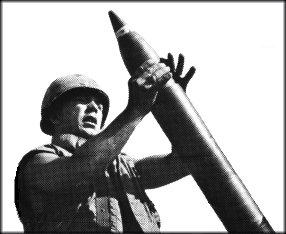 "You've got to build up experience to be a
good FDC," said Sp4 Thomas Stauflfer, Chief FDC for four-deuce in
the 2nd Battalion. "It takes a lot of cool to change the grid
coordinates without making a mistake into deflections and elevations
for the gunners under fire mission
pressures."
"You've got to build up experience to be a
good FDC," said Sp4 Thomas Stauflfer, Chief FDC for four-deuce in
the 2nd Battalion. "It takes a lot of cool to change the grid
coordinates without making a mistake into deflections and elevations
for the gunners under fire mission
pressures."
One of the best FDC's is Sp4
Freddie DeMars, of Columbus, Ga., after spending a good while in the
field as an 81mm Mortarman with Delta Company, 2nd
Bn.
And so it goes, day in and day out,
fire missions, adjustments, and tedious
drudgery.
"But, it all pays off," said
one Mortarman from Alabama as he stretched out in his hammock, "when
we bring the max on Charlie."
Pg 28 |
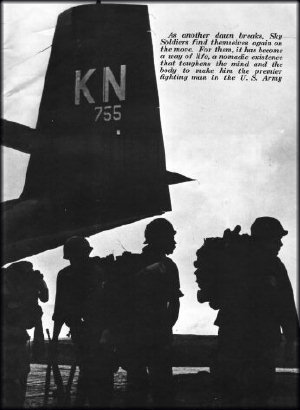 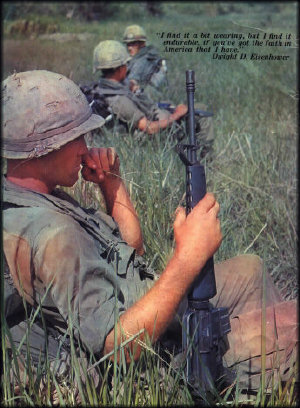 |
|
Rear Inside Cover and Rear
Cover | |